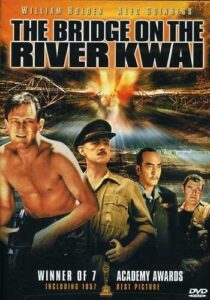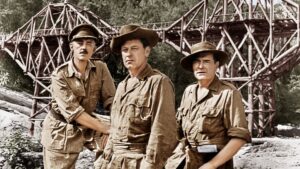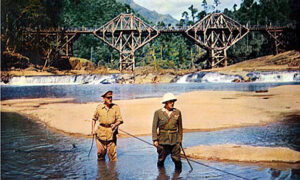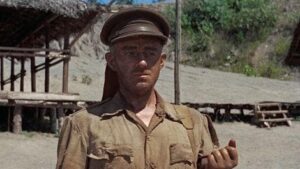“The Bridge on the River Kwai” – and the Bridge Still Stands Today…

Title: “The Bridge on the River Kwai”
Release Date: 1957
Director: David Lean
Cast: Alec Guiness, William Holden, Sessue Hayakawa, Jack Hawkins, James Donald, Geoffrey Horne
“The Bridge on the River Kwai” is set during World War II, in 1943 in Thailand. The film is based on a novel by Pierre Boulle, a former prisoner of a Japanese POW camp. The plot centers around the construction of a railroad line from Malaya to Burma. The Japanese, who were on the offensive against British territories in Asia due to the constant bombardment of their positions in the Andaman Sea, decided to construct an overland route through the jungle to transport weapons and food from Thailand to Burma.
The construction of the Burma Railway was an insanely difficult undertaking. The section on the river near Kanchana Buri proved particularly dangerous. The events depicted in The Bridge on the River Kwai are about this very area. An estimated 330,000 people worked on the railroad, including 60,000 prisoners of war. Nearly one third of them died.
The action of David Lean’s film begins in 1943, when the Japanese have little time left to finish building the railroad. Here, Colonel Nicholson’s (Alec Guinness) unit arrives at the POW camp, having been taken prisoner in Singapore. The British commander does not want to accept the prevailing conditions and demands that Colonel Saito (Sessue Hayakawa), who manages the camp in accordance with the Geneva Convention, not use the officers for manual labor. The two opponents, both equal in military rank, begin to wage a psychological battle with each other, in which Colonel Nicholson ultimately wins. Intoxicated with his moral victory, the Britisher decides to go a step further: he wants to show the Asians what the civilizing genius of the West means and, together with his soldiers, build a bridge that “will last 600 years”. Satisfied with this turn of events, Saito gives the British a free hand.

Nicholson enthusiastically embarks on the project. Soon it turns out that in order to make it in time, he has to hire his own officers for manual labor (breaking the rules of the convention, for which he fought so hard), and even enlists the help of the sick from the hospital.
Meanwhile, American Commander Shears (William Holden) escapes from the camp and miraculously makes it to Ceylon. After a short convalescence, however, Shears’ command sends him back to the jungle to lead a small group of commandos to blow up a bridge. Unluckily, Colonel Nicholson, who is admiring his work, notices the explosives and raises the alarm. A shootout breaks out in which all the main characters are killed, and the body of a dead Briton falling to the ground unlocks the bombs. The bridge is destroyed.
“The Bridge on the River Kwai” is based on a true episode from World War II – the construction of the Burma Railway – but is not faithful to historical truth. The bridge was never destroyed, although the Allies bombed it from the air. Nor was there ever any attempt to blow up the structure from land, and moreover, no one managed to escape from the camps in the Thai jungle.
“The Bridge on the River Kwai” – The Geneva Convention versus the Bushido Code
“The Bridge on the River Kwai” presents an extremely interesting juxtaposition of psychological portraits. Of course Nicholson’s character comes to the fore, phenomenally created by Alec Guinness, rightly awarded an Oscar for his performance. The Colonel is a character that evokes in the viewer alternately admiration, irritation and antipathy. We get to know him as a man of honor, an officer of the old pre-war guard – able to defend principles at any cost. During his psychological struggle with Saito, however, we gradually begin to see cracks in Nicholson’s attitude: does it make sense to defend the letter of the law at the cost of human suffering? When the Colonel wins this duel, it seems that his resistance has paid off.

Soon after, nonetheless, Nicholson betrays an almost morbid ambition to demonstrate his mental superiority to the enemy while building a bridge. Admittedly, the rationale behind the character’s behavior is well-founded: the commander wants to maintain the morale of his soldiers at all costs, so he assigns them a demanding task. However, it is hard not to notice that the erection of a bridge to contribute to the victory of the enemy is sheer stupidity, and even, as the military doctor signals to the colonel, can be seen as mere collaboration.
But here, too, one can try to defend Nicholson’s attitude: he is, above all, a soldier accustomed to blindly following orders and following the code. He does not have to think – he has to follow the soldier’s rules. In this sense, Nicholson’s words to the doctor, that he may be a good medic, but “he still has a lot to learn about the army,” acquire an ironic edge. It is the army that appears here as a soulless creature killing all individuality, and therefore also independent, critical thinking. On the other hand, the British colonel, obsessively faithful to the regulations, breaks the rules of the Geneva Convention himself: when it seems that the construction of the bridge will not be completed on time, he does not hesitate to hire officers and even sick people to do the physical work. His most important motive for action, then, is nevertheless hubris, which can be read as a symbol of British imperialism.
Nicholson’s antagonists in “The Bridge on the River Kwai” are Colonel Saito and the American commander. Saito is also an extremely complicated character: at first appearing as a sadistic madman, he gradually gains understanding from the viewer. The Japanese commander is not guided by the Geneva Convention, but by the Bushido Code (the two codes, incidentally, become an apt symbol of the opposition between East and West). If he does not build the bridge in time, it will be a disgrace for him, which he can erase only by suicide. So do the measures taken by Saito seem completely illogical?

Instead, the American’s attitude in “The Bridge on the River Kwai” is not based on any codified and abstract system of principles. His motto is simply to stay alive. He doesn’t care about conventions or even heroic deeds. He goes into the jungle again only under blackmail: the command has learned that he is a private soldier who has appropriated the identity of his late superior in the hope of better treatment in the camp. Nevertheless, it is Shears who displays the most altruistic attitude, even heroism. Despite clear orders, he does not leave a wounded comrade delaying the trek. Instead, in the story’s finale, the commander heroically sacrifices his life to finally blow up the bridge. Shears becomes the voice of human values in a world ruled by heartless rules.
“The Bridge on the River Kwai” – an anti-war spectacle
It should be emphasized that “The Bridge on the River Kwai” is a wonderful film spectacle, which at the same time has an unambiguously anti-war message. The film was shot in Ceylon, because the surroundings of the real Bridge on the River Kwai are not that impressive. From the very first scenes we are faced with exotic landscapes with magnificent, vivid colors. Impressive are also the monumental, panoramic scenes of the bridge erection.
This paradise-like, sunny scenery contrasts sharply with the situation of the prisoners and their murderously hard work. This dissonance is brilliantly signaled in the opening sequence of Lean’s film: amidst the lush vegetation, the camera’s eye suddenly slips on ominous white crosses. In this way, the director builds an atmosphere of danger – we already know that real evil lurks inside this paradise.
It is similar with the film’s music: Colonel Bogey’s march, joyfully whistled by Nicholson’s squad, becomes the main theme of the film’s soundtrack. The melody continually emphasizes the peculiar paradoxical nature of the situation of British soldiers in Japanese captivity. What is more, it harmonizes with the general atmosphere and meaning of the film, which foregrounds the grotesqueness and absurdity of any war. The message of “The Bridge on the River Kwai” is captured most succinctly by a military doctor arriving on the battlefield, where all the enemy are killed: “Madness… madness!
Literature:
A.Garbicz, J. Klinowski, Kino, wehikuł magiczny. Przewodnik osiągnięć filmu fabularnego. Podróż druga 1950 – 1959,
